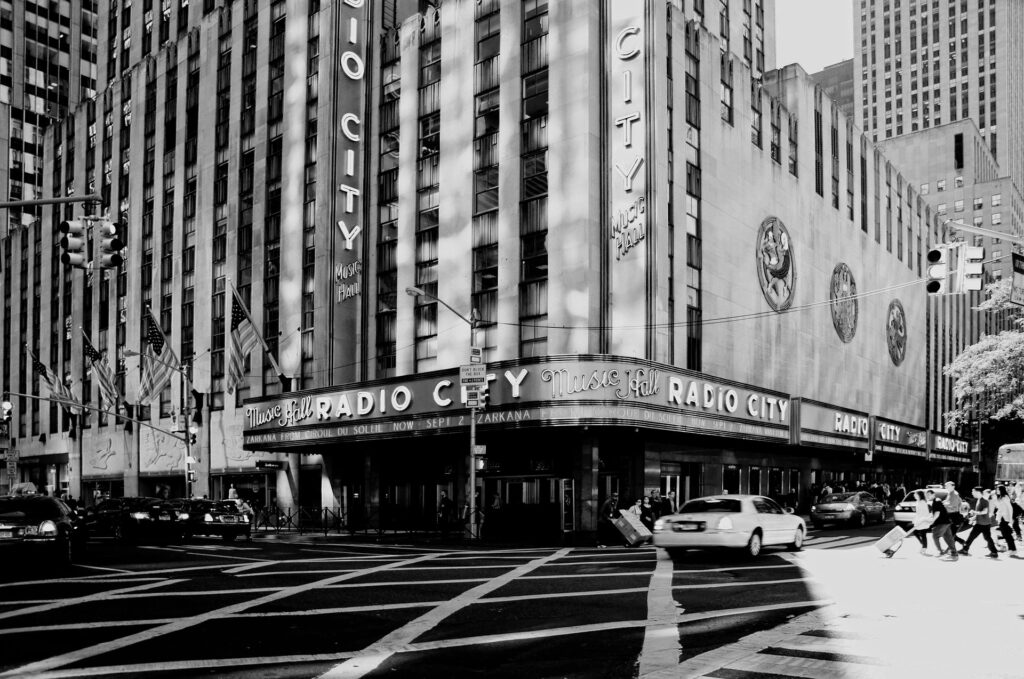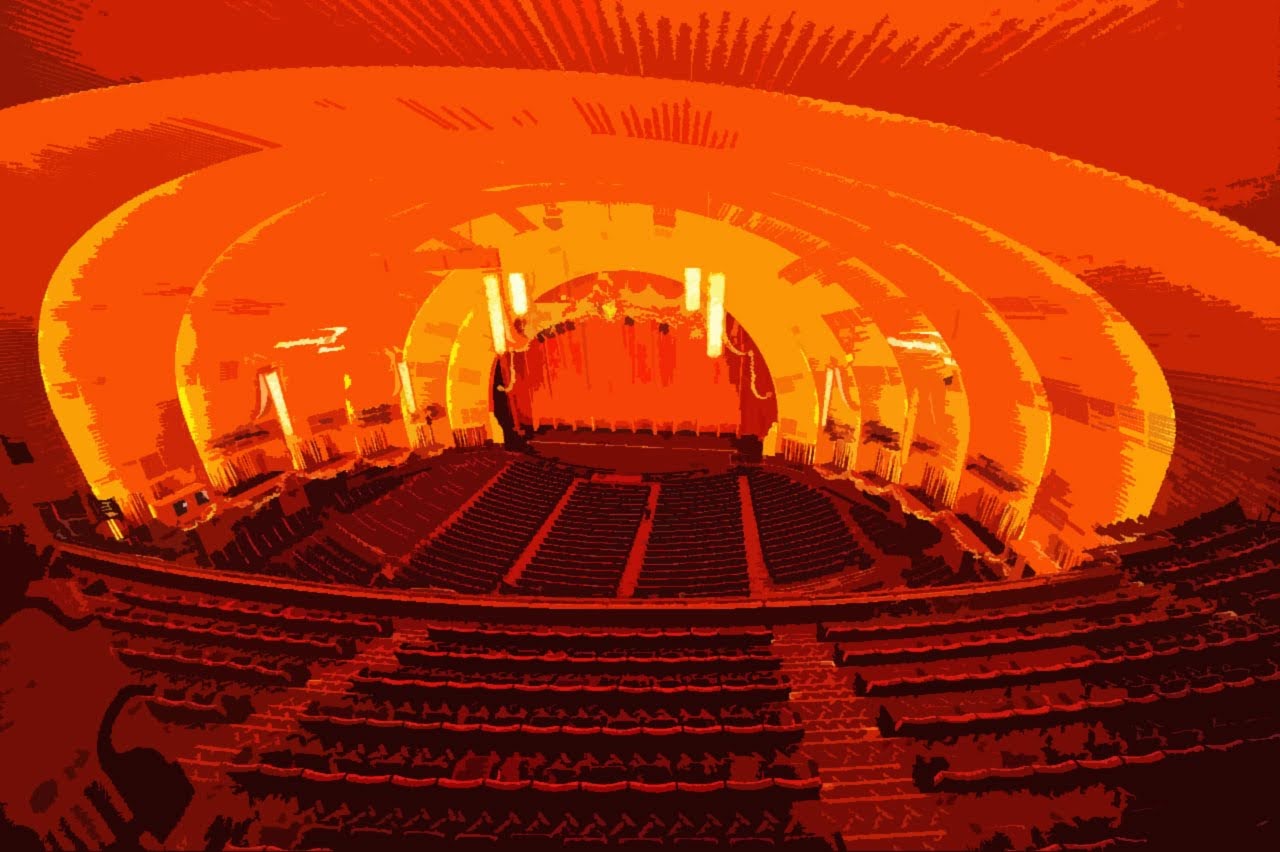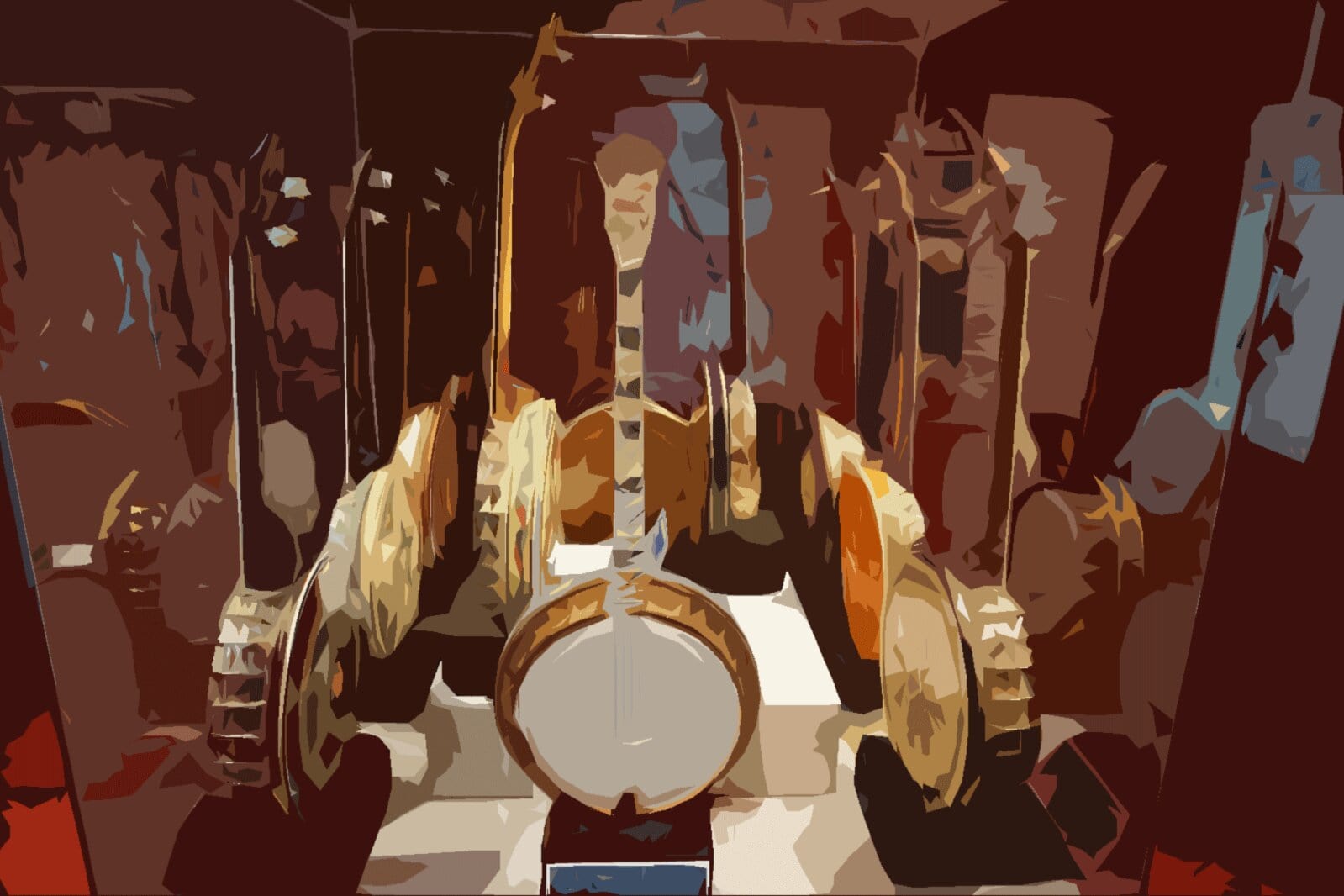Listen Below:
By Jason Epperson
New York City. The bright lights of Broadway shine on no less than 40 of the greatest stages on earth, and yet, one venue in the Big Apple outshines all others – Radio City Music Hall.
Creating Radio City Music Hall:
The construction of Rockefeller Center occurred between 1932 and 1940 on land that John D. Rockefeller Jr. leased from Columbia University. The site was originally supposed to be occupied by a new opera house for the Metropolitan Opera. Benjamin Wistar Morris and designer Joseph Urban were hired to come up with blueprints for the house. However, the new building was too expensive for the opera to fund by itself, and it needed an endowment, and the project ultimately gained the support of John D. Rockefeller Jr. The planned opera house fell through, but Rockefeller made a deal with RCA to develop Rockefeller Center as a mass media complex with four theaters, later downsized to two.
Samuel Roxy Rothafel, a successful theater operator who was renowned for his domination of the city’s movie theater industry, joined Rockefeller center’s advisory board and offered to build two theaters: a large vaudeville “International Music Hall” on the northernmost block with more than 6,200 seats, and the smaller 3,500-seat “RKO Roxy” movie theater on the southernmost block. The idea for these theaters was inspired by Roxy’s failed expansion of the Roxy Theatre on 50th Street, one and a half blocks away.
Roxy had a list of design requests for the Music Hall. First, he did not want it to have either a large balcony over the box seating or rows of box seating facing each other, as traditionally found in opera houses. This resulted in a “tiered” balcony system where several shallow balconies were built at the back of the theater, cantilevered off the back wall. Second, He specified the auditorium to be built in an oval shape, as contemporary wisdom held that oval-shaped auditoriums had better acoustic qualities. He imagined an elaborate hydraulic stage system, with the ability to change sets in a flash, and finally, he wanted to build at least 6,201 seats in the Music Hall so it would be larger than the Roxy. There were only 5,960 audience seats in the Rox’s main auditorium, but he also counted elevator stools, orchestra pit seats, and dressing-room chairs.
Despite Roxy’s specific requests for design features, the Music Hall’s general design was determined by the Associated Architects, the architectural consortium that was designing the rest of Rockefeller Center. The Radio City Music Hall was designed by architect Edward Durell Stone and interior designer Donald Deskey in the Art Deco style. Stone used Indiana Limestone for the facade, as with all the other buildings in Rockefeller Center, but he also included some distinguishing features. Three 90-foot-tall signs with the hall’s name on it were placed on the facade, while intricately ornamented fire escapes were installed on the walls facing 50th and 51st Streets.
Inside, Stone designed 165-foot-long Grand Foyer with a large staircase, balconies, and mirrors, and commissioned Ezra Winter for the grand foyer’s 2,400-square-foot mural, “Quest for the Fountain of Eternal Youth.” Deskey, meanwhile, was selected as part of a competition for interior designers for the Music Hall. He had reportedly called Winter’s painting “God-awful” and regarded the interior and exterior as not much better. He designed custom rococo upholstery and furniture for the hall.
The stagehouse would be a grand accomplishment all to its own. Its innovative elevator system is a forerunner of other stage designs as well as aircraft carrier systems built in World War II. These elevators can handle people, animals, props, and scenery at variable speeds, delivering them to the stage or above and dropping out of sight. The orchestra, generally placed in front of the stage, actually rides on a “bandwagon” — a self-propelled car, accommodating 35 musicians, their instruments, and two grand pianos. It can travel horizontally or vertically along an elevator shaft that allows it to shuttle back and forth from the sub-basement level to the rear of the stage. The orchestra can appear in front of performers on stage and then a few minutes later rise up behind them, all when the musicians are playing.
The other three platform stages (each 70 feet wide and 12-16 feet deep) move, using a hydraulic system, independently or together, 27 feet below to 13 feet above the stage level, at a rate of 1 foot a second. When the three platform stages are at the same elevation, they can combine into a 43-foot diameter turntable that rotates (on rollers driven by a motor) in either direction.
The International Music Hall later became the Radio City Music Hall, deriving from one of the complex’s first tenants, the Radio Corporation of America, or RCA, who had planned a mass media complex called Radio City on the west side of Rockefeller Center.

Construction on Radio City Music Hall started in December 1931, and the hall topped out in August 1932, just 9 months later. Its construction set many records at the time, including the use of 15,000 miles of copper wire and 200 miles of brass pipe. In November 1932, Russell Markert’s précision dance troupe the Roxyettes (later to be known as the Rockettes) left the Roxy Theatre and announced that they would be moving to the Music Hall. By then, Roxy was busy adding music acts in preparation for the hall’s opening at the end of the year.
The Music Hall opened to the public on December 27, 1932, with a lavish stage show featuring Ray Bolger, Doc Rockwell, and Martha Graham. The opening was meant to be a return to high-class variety entertainment, however, it wasn’t a success: the program was very long, spanning from 8 p.m. to 2 a.m., and many acts were crammed onto the world’s largest stage at the same time, ensuring that they would be lost in the cavernous hall. As the premiere went on, audience members, including John Rockefeller Jr, waited in the lobby or simply left early. Some news reporters, tasked with writing reviews of the premiere, guessed the ending of the program because they left beforehand. One wrote that “if the seating capacity of the Radio City Music Hall is precisely 6,200, then just exactly 6,199 persons must have been aware at the initial performance that they were eyewitnesses to the unveiling of the world’s best ‘bust.’” Set designer Robert Edmond Jones resigned in disappointment, and Graham was fired. Despite the negative reviews of the performances, the theater’s design was very well received, with one critic saying “it needs no performers; its beauty and comforts alone are sufficient to gratify the greediest of playgoers.”
On January 11, 1933, after incurring a net operating loss of $180,000, the Music Hall converted to the then familiar format of a feature film, with a spectacular stage show that Roxy had perfected. The first film shown on the giant screen was Frank Capra’s The Bitter Tea of General Yen, and the Music Hall became the premiere showcase for films from the RKO-Radio Studio, with Topaze the first RKO film to play there.[62] The film-plus-stage-spectacle format continued at the Music Hall until April 25, 1979, with four complete performances presented every day.
Films that premiered at Radio City Music Hall included King Kong, Breakfast at Tiffany’s, To Kill a Mockingbird, Mary Poppins, and The Lion King.
Through the 1960s, the Music Hall was successful regardless of the status of the city’s economic, business, or entertainment sectors as a whole. It remained open even as other theaters such as the Paramount and the Roxy closed. Even so, officials had intended to close down Radio City Music Hall in 1962. Operating costs were almost twice as high as those of smaller performance venues. But the venue pressed on, and by the early 1970s, changes in film distribution made it difficult for Radio City Music Hall to secure exclusive bookings of many films, and management preferred to show only G-rated movies, which further limited their film choices as the decade wore on. Popular films, such as Blazing Saddles, and The Godfather Part II, failed to meet the Music Hall’s screening criteria.
By 1972, the Music Hall was forced to part ways with performers’ unions and six of the thirty-six Rockettes. A painting was donated to the Museum of Modern Art to reduce Radio City Music Hall’s tax burden. In 1977, annual attendance reached an all-time low of 1.5 million, a 70% decrease from the 5 million visitors reported less than a decade prior.
By January 1978, officials stated that the Radio City Music Hall would close in the spring. Plans included converting the theater into tennis courts, a shopping mall, an aquarium, a hotel, a theme park, or a Stock Exchange. Upon hearing the announcement, Rosemary Novellino, Dance Captain of the Radio City Music Hall Ballet Company, formed the Showpeople’s Committee to Save Radio City Music Hall. The Committee consisted of an alliance between performers, the media, and political allies. The public made thousands of calls to Rockefeller Center and to city officials, and the Rockettes protested outside City Hall.
Following the closure announcement, the interior was made a city landmark, a move designed by the city to stop any remodeling. Rockefeller Center Inc. unsuccessfully filed a lawsuit to try to reverse the designation. On April 8, four days before the planned closing date, the Empire State Development Corporation voted to create a nonprofit subsidiary to lease the Music Hall. One month later, Radio City Music Hall was placed on the National Register of Historic Places.

Plans for a 20-story mixed-use tower above the Radio City Music Hall were announced in April 1978, with rents from providing the necessary funds to keep the hall open. The office building was ultimately not built, and Rockefeller Center Inc. instead decided to restore Radio City Music Hall to its original condition.
Operators diversified the selection of shows and performances. Time slots were set aside for movie screenings, but the Music Hall had mostly turned to stage shows, such as the stage adaptation of Snow White and the Seven Dwarfs and the Rockettes Spectacular. However, the theatrical shows proved to be unpopular, so in 1983, the Hall shifted to creating music concerts and participating in the production of films and TV shows. The parent company, Radio City Music Hall Productions, started creating or co-creating films and Broadway shows such as Legs and Brighton Beach Memoirs. In 1985, Radio City Music Hall finally recorded its first profit in three decades, with a net gain of $2.5 million, partly attributed to the addition of music concerts, which appealed toward younger audiences. The Music Hall also started hosting televised events including the Grammy Awards, the Tony Awards, the Daytime Emmy Awards, the MTV Video Music Awards, and the NFL Draft.
Visiting Radio City Music Hall:
In 1997, Radio City Music Hall was leased to the Madison Square Garden Company (then known as Cablevision). This move provided funding to keep the Rockettes and the Christmas Spectacular at the Music Hall; in addition, Cablevision would be able to renovate and manage the hall. Radio City Music Hall was closed on February 16, 1999, for a comprehensive revitalization. During the closure, many components were cleaned and modernized. The curtains were replaced, seats were reupholstered, carpets were relaid, and doorknobs and light fixtures were replaced.The renovation was originally projected to cost $25 million, but later increased to $70 million.
The Hall is closed to the public today, as is virtually an entire industry of performers, technicians, ushers, custodians, box office staff, producers, designers, and all the ancillary industries that are attached to the performing arts and live events. This industry employs hundreds of thousands of people nationwide, and is facing many more months of closure. Broadway will be closed until at least summer of 2021, and it could be longer. As former members of this industry ourselves, Abigail and I encourage you to support legislation that helps keep these hard-working Americans afloat during this difficult time.
Connect and Subscribe:
To learn more about the RV Miles Network, including the RV Miles and America’s National Parks Podcasts, visit RVMiles.com.
You can hear this story and more on the See America Podcast. Available on Apple Podcasts or wherever you listen to podcasts.
Want to chat about great travel destinations all across the US? Join the See America Facebook Group and don’t forget to follow See America on Instagram, Facebook, and YouTube.

See America is sponsored by Roadtrippers. America’s #1 trip planning app. Enjoy 20% off your first year of Roadtrippers PLUS with the code RVMILES2X.






